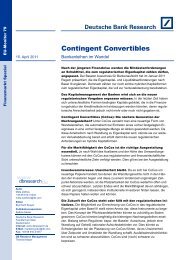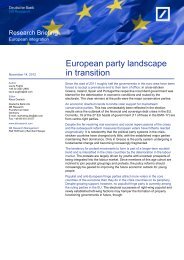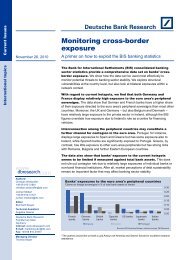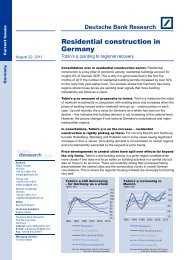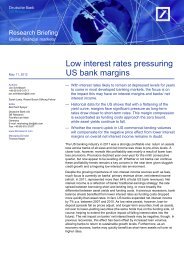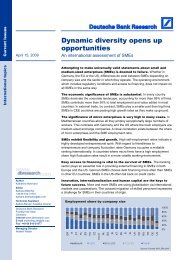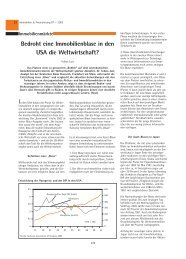Container shipping: Successful turnaround - Deutsche Bank Research
Container shipping: Successful turnaround - Deutsche Bank Research
Container shipping: Successful turnaround - Deutsche Bank Research
You also want an ePaper? Increase the reach of your titles
YUMPU automatically turns print PDFs into web optimized ePapers that Google loves.
Fuel consumption cut by<br />
slow steaming<br />
Speed-dependent (knots) fuel<br />
consumption, tonnes per day<br />
14<br />
12<br />
10<br />
8<br />
6<br />
4<br />
2<br />
24 20.1 17.3<br />
Ship with lot capacity of 8,000 TEU<br />
Ship with lot capacity of 6,000 TEU<br />
Number of laid-up ships<br />
has dropped sharply<br />
Number of laid-up container ships<br />
worldwide during the crisis<br />
0<br />
08 09 10<br />
Number of ships, right<br />
TEU share of total fleet, %, left<br />
250<br />
200<br />
150<br />
100<br />
50<br />
700<br />
600<br />
500<br />
400<br />
300<br />
200<br />
100<br />
Source: AXS-Alphaliner, VDR 14<br />
0<br />
Source: Drewry 13<br />
Order books for big ships<br />
well filled<br />
Fleet and orders on hand according to<br />
ship size class (million TEU), July 2010<br />
Up to 1,999 TEU<br />
2,000 to 4,999 TEU<br />
5,000 to 7,999 TEU<br />
8,000 to 9,999 TEU<br />
10,000 TEU and<br />
over<br />
0<br />
0 2 4 6<br />
Existing fleet Order book<br />
Source: Drewry 15<br />
Current Issues<br />
laying-up costs of several thousand dollars per day. At its peak<br />
some 12% of the global container <strong>shipping</strong> fleet was idle.<br />
In the end, the reduced lot capacity has helped average freight and<br />
charter rates to pick up again over the last few months – starting<br />
from a very low base of course. Ultimately, however, the key driver<br />
of the latest price increase was the growing demand for <strong>shipping</strong>.<br />
Overall, the level of charter rates is still low anyway on a long-term<br />
comparison.<br />
Further increase in capacity inevitable …<br />
This means that besides the growth in global demand for container<br />
<strong>shipping</strong> services it is primarily the ongoing capacity developments<br />
that are of special significance for the future earnings of the <strong>shipping</strong><br />
lines. Further capacity increases can be expected over the short and<br />
medium term. Already over the last few months the number of laidup<br />
ships has fallen dramatically and is currently just around 2% of<br />
the global fleet. With the economy picking up, the market for ship<br />
financing has shaken off the paralysis induced by the months-long<br />
crisis. Around the world, capital is once again flowing into the<br />
financing of container ships. In 2010 more new orders were placed<br />
for container ships after 2009 had brought hardly any new orders;<br />
last year’s orders were still some 40% lower than in 2008.<br />
Overall, the order books still contain a considerable number of<br />
orders placed in the pre-crisis years. Particularly container ships<br />
with a lot capacity of over 10,000 TEU are coming onto the market in<br />
greater numbers, even though it remains to be seen whether they<br />
can also be fully financed. In this segment the ordered capacity in<br />
mid-2010 was equivalent to nearly 400% of the available fleet in this<br />
size category (total fleet: 30%). These ships are ideal for the busy<br />
“expressway” routes, for example, between the Far East and Europe<br />
and North America, and they dock mainly at the big container ports.<br />
… but the likelihood of sufficient rates is higher<br />
All things being equal, the capacity expansion in big container ships<br />
will ramp up price pressure primarily in that segment, but ultimately<br />
across the entire sector. However, most of the big container ships do<br />
not compete directly with smaller ships that mainly provide feeder<br />
services or operate on less busy routes and where the volume of<br />
orders is not nearly so large. In addition, the market entry of ultralarge<br />
ships brings with it the need for smaller feeder vessels. This<br />
makes it very likely that individual routes and certain sizes of ship<br />
will encounter temporary bottlenecks that will probably result in<br />
higher prices.<br />
The friendly economic environment should, however, also allow the<br />
sector as a whole to generate adequate average profits over the<br />
next few years. Also, market observers like Drewry expect that the<br />
demand for container <strong>shipping</strong> will grow faster than the supply of<br />
new capacity over the next few years. And slow steaming is an<br />
option for flexibly adjusting capacity to potentially lower demand.<br />
Slow steaming could even become the rule rather than the<br />
exception for individual <strong>shipping</strong> lines and on particular routes since<br />
many ships have been equipped or refitted accordingly in recent<br />
years. Operating at slower speeds usually also boosts reliability<br />
(meeting delivery deadlines). Of course it is also clear that when<br />
demand rises sharply and rates are high that <strong>shipping</strong> lines will<br />
always seek to increase the number of round-trips per ship.<br />
Overall, the problem of overcapacity has thus eased currently. And<br />
on the demand side, too, the risks are modest at present: we expect<br />
6 March 28, 2011



